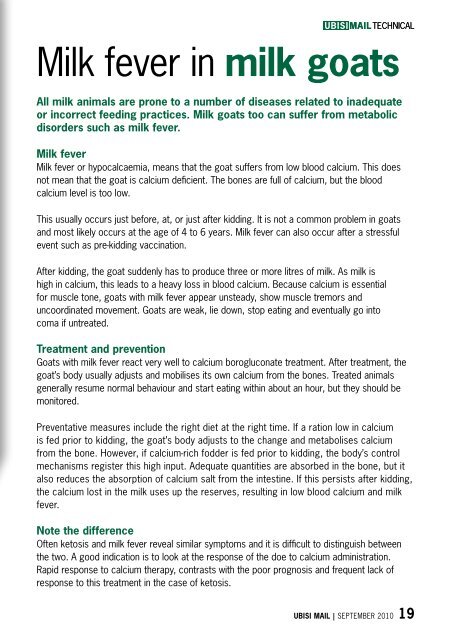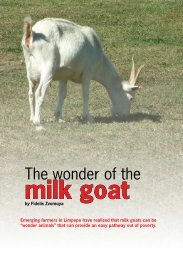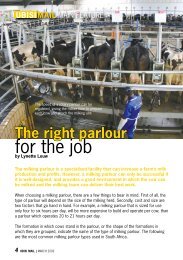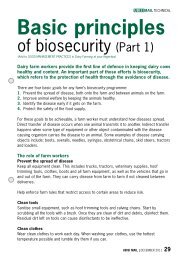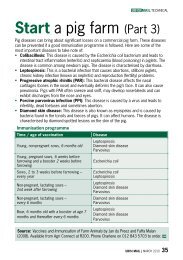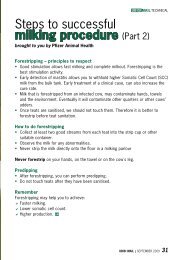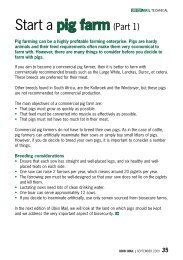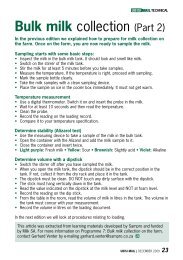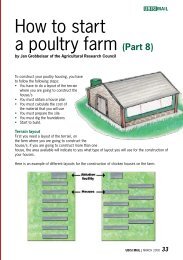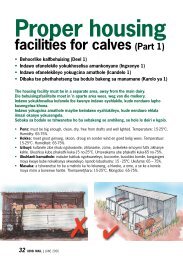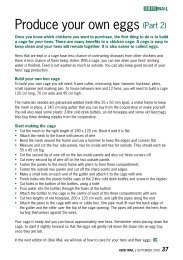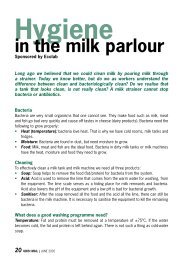Milk fever in milk goats - Ubisi Mail Magazine
Milk fever in milk goats - Ubisi Mail Magazine
Milk fever in milk goats - Ubisi Mail Magazine
- No tags were found...
You also want an ePaper? Increase the reach of your titles
YUMPU automatically turns print PDFs into web optimized ePapers that Google loves.
TECHNICAL<strong>Milk</strong> <strong>fever</strong> <strong>in</strong> <strong>milk</strong> <strong>goats</strong>All <strong>milk</strong> animals are prone to a number of diseases related to <strong>in</strong>adequateor <strong>in</strong>correct feed<strong>in</strong>g practices. <strong>Milk</strong> <strong>goats</strong> too can suffer from metabolicdisorders such as <strong>milk</strong> <strong>fever</strong>.<strong>Milk</strong> <strong>fever</strong><strong>Milk</strong> <strong>fever</strong> or hypocalcaemia, means that the goat suffers from low blood calcium. This doesnot mean that the goat is calcium deficient. The bones are full of calcium, but the bloodcalcium level is too low.This usually occurs just before, at, or just after kidd<strong>in</strong>g. It is not a common problem <strong>in</strong> <strong>goats</strong>and most likely occurs at the age of 4 to 6 years. <strong>Milk</strong> <strong>fever</strong> can also occur after a stressfulevent such as pre-kidd<strong>in</strong>g vacc<strong>in</strong>ation.After kidd<strong>in</strong>g, the goat suddenly has to produce three or more litres of <strong>milk</strong>. As <strong>milk</strong> ishigh <strong>in</strong> calcium, this leads to a heavy loss <strong>in</strong> blood calcium. Because calcium is essentialfor muscle tone, <strong>goats</strong> with <strong>milk</strong> <strong>fever</strong> appear unsteady, show muscle tremors anduncoord<strong>in</strong>ated movement. Goats are weak, lie down, stop eat<strong>in</strong>g and eventually go <strong>in</strong>tocoma if untreated.Treatment and preventionGoats with <strong>milk</strong> <strong>fever</strong> react very well to calcium borogluconate treatment. After treatment, thegoat’s body usually adjusts and mobilises its own calcium from the bones. Treated animalsgenerally resume normal behaviour and start eat<strong>in</strong>g with<strong>in</strong> about an hour, but they should bemonitored.Preventative measures <strong>in</strong>clude the right diet at the right time. If a ration low <strong>in</strong> calciumis fed prior to kidd<strong>in</strong>g, the goat’s body adjusts to the change and metabolises calciumfrom the bone. However, if calcium-rich fodder is fed prior to kidd<strong>in</strong>g, the body’s controlmechanisms register this high <strong>in</strong>put. Adequate quantities are absorbed <strong>in</strong> the bone, but italso reduces the absorption of calcium salt from the <strong>in</strong>test<strong>in</strong>e. If this persists after kidd<strong>in</strong>g,the calcium lost <strong>in</strong> the <strong>milk</strong> uses up the reserves, result<strong>in</strong>g <strong>in</strong> low blood calcium and <strong>milk</strong><strong>fever</strong>.Note the differenceOften ketosis and <strong>milk</strong> <strong>fever</strong> reveal similar symptoms and it is difficult to dist<strong>in</strong>guish betweenthe two. A good <strong>in</strong>dication is to look at the response of the doe to calcium adm<strong>in</strong>istration.Rapid response to calcium therapy, contrasts with the poor prognosis and frequent lack ofresponse to this treatment <strong>in</strong> the case of ketosis.UBISI MAIL | SEPTEMBER 2010 19
Goats: <strong>Milk</strong> <strong>fever</strong>A goat may suffer from low blood calciumlevels just before or after kidd<strong>in</strong>g. Whenthe goat starts to produce <strong>milk</strong> thecalcium <strong>in</strong> her blood is used up quickly.Symptoms: Walks unsteady, muscle tremors,weak, lies down, stops eat<strong>in</strong>g, could go <strong>in</strong>to coma if untreated.Treatment: Inject calcium. The goat should start eat<strong>in</strong>g with<strong>in</strong> an hour.Prevention: Feed a ration low <strong>in</strong> calcium prior to kidd<strong>in</strong>g. This stimulates the absorption ofcalcium from the food <strong>in</strong> the <strong>in</strong>test<strong>in</strong>e.Bokke: melkkoors’n Bok kan lae bloedkalsiumvlakke hê net voor of ná lamtyd. Sodra ’n bokbeg<strong>in</strong> melk produseer, word die kalsium <strong>in</strong> haar bloed gou opgebruik.Simptome: Stap wankelrig, spiersametrekk<strong>in</strong>gs, swakheid, bly lê, hou op vreet, kan <strong>in</strong>koma gaan, <strong>in</strong>dien nie behandel nie.Behandel<strong>in</strong>g: Kalsium<strong>in</strong>spuit<strong>in</strong>g. Die bok salb<strong>in</strong>ne ’n uur beg<strong>in</strong> vreet.Voorkom<strong>in</strong>g: Voer ’n rantsoen laag <strong>in</strong> kalsiumvoor die bok lam. Dit stimuleer die absorpsievan kalsium van die kos <strong>in</strong> die dermkanaal.Izimbuzi: Imfiva YobisiImbuzi <strong>in</strong>gaba namaz<strong>in</strong>ga aphansi ekhalisiyamu egaz<strong>in</strong>i ngokusheshangaphambi kokuba ibe nez<strong>in</strong>yane noma ngemuva kwaloko. Uma imbuzi iqalaukukhiqiza ubisi ikhalisiyamu egaz<strong>in</strong>i layo isetshenziswa iphele ngokushesha.Izimpawu: Ihamba ngokudengezela, imisipha iyaqhaqhazela, ibuthakathaka, ilala phansi, iyekaukudla, <strong>in</strong>gangena esihlwath<strong>in</strong>i (ku-coma) uma <strong>in</strong>gelashwa.Ukwelashwa: Yijove ngekhalisiyamu. Imbuzi kumele iqale ukudla ngaphakathi kwesikhathiesiyihora.Ukuvikela: Yidlise isabelo sekhalisiyamu esiphansi ngaphambi kokuba ibe nez<strong>in</strong>yane.Igqugquzela ukumuncwa kwekhalisiyamu ukusuka ekudleni okungaphakathi kwethumbu.20 UBISI MAIL | SEPTEMBER 2010
TECHNICALDipodi: Feberu ya lebesePodi e ka ba le bothata ba ho theoha ha ditekanyo tsa khalsiamomad<strong>in</strong>g pele kapa ka mora hore e tswale potsanyane. Ha podi etla ho hlahisa lebese khalsiamo mad<strong>in</strong>g a yona e sebediswakapele.Matshwao a ho kula: Ho tsamayae thekesela, ho thothomela hamesifa, ho fokola, ho robalafatshe, ho kgaotsa ho ja, hoakgeha ka nako e telele haebae sa alashwe.Kalafo: Ho e hlaha ka lemaole nang le khalsiamo. Podi etshwanetse ho qala ho ja nakongya hora.Thibelo: E fepe ka dijo tse nangle khalsiamo e tlase pele e tswalapotsanyane. Sena se kgothaletsaho mongwa ha khalsiamo dijongtse leng ka maleng.Iibhokhwe: Umkhuhlane wobisiIbhokhwe <strong>in</strong>okuba namanqanaba asezantsiekhalsiyam yegazi ms<strong>in</strong>yane nje okanye emvakokuzala. Xa iqala ukukhupha ubisi ibhokhweikhalsiyam esegaz<strong>in</strong>i layo isetyenziswangokukhawuleza.Iimpawu: Iyagxadazela xa ihamba, ukungcangcazelakwezihlunu, ibe buthathaka, ilale phantsi, iyeke ukutya,<strong>in</strong>okufa isiqaqa ukuba ay<strong>in</strong>yangwanga.Unyango: Yitofe ngekhalsiyam. Ibhokhwe kufuneka iqale ukutya kwiyure.Uth<strong>in</strong>telo: Yondle ngereyish<strong>in</strong>i enekhalsiyam esezantsi phambi kokuba izale. Okukuvuselela ukufunxwa kwekhalsiyam ekutyeni okusemathunj<strong>in</strong>i. UMUBISI MAIL | SEPTEMBER 2010 21


